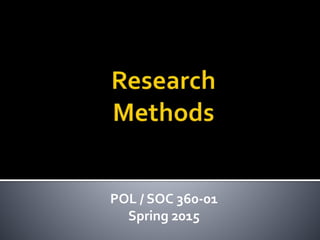
POL SOC 360 Conceptualization
- 1. POL / SOC 360-01 Spring 2015
- 4. Goal #1: What are concepts? What is operationalization? Why should we care? Goal #2: How do concepts serve as different kinds of variables? Goal #3: What role do variables play in formulating hypotheses?
- 7. INSTRUCTIONS Partner with someone in your major. What concepts make up either the political or social world? Be prepared to share your thoughts.
- 8. Examples in Political Science Nations Governmental Systems Political Ideology Individuals Examples in Sociology Class Religiosity Health
- 9. What is a concept? Idea or mental construct representing real world Why should we care about concepts? What purposes do they serve?
- 10. Accurate, Precise, and Informative ProvideTools for Communication Develop a Perspective Avoid “Fallacy of Reification” Allow Generalization and Classification Components ofTheories NeitherTrue or False
- 16. Single Dimension Concepts Socioeconomic Status (SES) Cultural Fragmentation Multi-Dimensional Concepts Liberalism Democracy
- 18. INSTRUCTIONS In small groups, think of two concepts (one in political science and one in sociology) and provide operational definitions for each.
- 20. Clarify relationships between phenomena R = PB – C +D R = Reward gained from voting in election; proxy for turnout P = Probability of vote “mattering” B = Benefits ofVoting C = Costs ofVoting D = “Civic Duty” psychological benefits)
- 21. (1) Clinton (2) (3) (4) Bush (5) (6) VARIABLES Foreign Economic Domestic Foreign Economic Domestic Tenure in Office (12.82) 11.46) (4.94) (18.44) * (6.55) (11.92) * (1.23) (1.32) (0.36) (2.49) (1.82) (2.11) Second Term (-65.88) (-92.87) (-199.73) (-345.08) * -352.07) ** (-447.04) ** (-0.75) (-1.27) (-1.71) (-1.98) (-4.16) (-3.37) Presidential Approval (-2.21) (-6.00) (-2.06) (11.94) * (2.89) 2.41) (-0.47) (-1.51) (-0.33) (2.40) (1.19) (0.64) Divided Government (-45.74) (-149.01) ** (-156.05) (-147.36) * (-109.60) ** -103.90) (-0.67) (-2.60) (-1.71) (-2.11) (-3.23) (-1.95) Unemployment Rate (-303.13) (863.56) (854.89) (-524.54) (-679.34) ** -629.65) * (-0.49) (1.66) (1.03) (-1.48) (-3.95) (-2.33) Inflation Rate (-39.63) (-8.57) (12.44) (-9.71) (0.64) -10.08) (-1.54) (-0.40) (0.36) (-0.61) (0.08) (-0.83) Presidential Election (51.19) (-111.89) (-113.16) (-97.16) (-39.64) 14.73) (0.67) (-1.75) (-1.11) (-0.72) (-0.60) (0.14) Midterm Election (82.39) (-97.12) * (2.67) (118.14) (5.15) 91.11) (1.82) (-2.57) (0.04) (1.59) (0.14) (1.61) Election Season (-85.19) (254.59) ** (399.31) ** (435.80) * 272.93) ** 638.33) ** (-0.75) (2.69) (2.64) (2.28) (2.94) (4.38) Constant (6,816.18) (131.35) (-2,721.79) (2,273.87) 968.11) 2,933.50) (1.95) (0.04) (-0.58) (0.78) (0.68) (1.32) Observations 95 95 95 95 95 95 R-squared 0.12 0.30 0.21 0.26 0.40 0.46 Note: z-statistics in parentheses. ** p<0.01, * p<0.05
- 23. IndependentVariable DependentVariable AntecedentVariable InterveningVariable
- 25. INSTRUCTIONS Think about the topic for your survey research project. Sketch out a simple arrow diagram that includes an independent variable and a dependent variable. Bonus points if your diagram includes an antecedent variable or intervening variable.
- 26. Arrow diagrams can get quite complex, as shown by these examples of determining vote choice.
- 28. An educated guess representing the proposed explanation for some phenomenon Indicates relationship between independent variable and dependent variable Emphasis on proposed explanations
- 29. Empirical Statement Generalizability Plausibility Specificity Corresponds toTest Testability Linkage Makes Sense
- 30. Directional Hypothesis Positive or Direct Relationship Negative or Inverse Relationship Non-Directional Hypothesis Comparison among categories Null Hypothesis No relationship between IV and DV
- 31. INSTRUCTIONS Choose a subject in political science or sociology . Write the following: Directional Hypothesis (Positive or Negative) Non-Directional Hypothesis Null Hypothesis
- 33. CALCULUS OFVOTING RQ: Why do people participate in elections? Theory: R= pB-C + D (Downs 1957, Riker and Ordeshook 1968) Hypothesis: Turnout increases with easier registration requirements MEDIANVOTERTHEORY RQ: What explains variation in positions taken by political candidates? Theory:Voters choose party (and candidate) closely reflecting preferences Hypothesis: Party appeals to “median voter” has higher likelihood of winning election